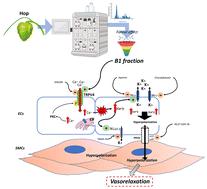当前位置:
X-MOL 学术
›
Food Funct.
›
论文详情
Our official English website, www.x-mol.net, welcomes your feedback! (Note: you will need to create a separate account there.)
α acid fraction from Hop extract exerts an endothelium-derived hyperpolarization vasorelaxant effect through TRPV4 employing the feedforward mechanism of PKCα
Food & Function ( IF 6.1 ) Pub Date : 2024-03-20 , DOI: 10.1039/d4fo00058g Paola Di Pietro 1 , Emanuela Salviati 2 , Antonio Damato 3 , Valeria Prete 1 , Angela Carmelita Abate 1 , Pietro Campiglia 2 , Carmine Vecchione 1, 3 , Eduardo Sommella 2 , Albino Carrizzo 1, 3
Food & Function ( IF 6.1 ) Pub Date : 2024-03-20 , DOI: 10.1039/d4fo00058g Paola Di Pietro 1 , Emanuela Salviati 2 , Antonio Damato 3 , Valeria Prete 1 , Angela Carmelita Abate 1 , Pietro Campiglia 2 , Carmine Vecchione 1, 3 , Eduardo Sommella 2 , Albino Carrizzo 1, 3
Affiliation

|
Until now, the beneficial vascular properties of Hop reported in the literature have been mainly attributed to specific compound classes, such as tannins and phenolic acids. However, the potential vascular action of a Hop subfraction containing a high amount of α or β acids remains completely understood. Therefore, this study aims to investigate the vascular effects of the entire Hop extract and to fraction the Hop extract to identify the main bioactive vascular compounds. A pressure myograph was used to perform vascular reactivity studies on mouse resistance arteries. Phytocomplex fractionation was performed on a semi-prep HPLC system and characterized by UHPLC-PDA-MS/MS coupled to mass spectrometry. Western blot analysis was performed to characterize the phosphorylation site enrolled. The entire Hop extract exerts a direct dose-dependent endothelial vascular action. The B1 subfraction, containing a high concentration of α acids, recapitulates the vascular effect of the crude extract. Its vasorelaxant action is mediated by the opening of Transient Receptor Potential Vanilloid type 4 (TRPV4), potentiated by PKCα, and subsequent involvement of endothelial small-conductance calcium-activated potassium channels (SKCa) and intermediate-conductance calcium-activated potassium channels (IKCa) that drives endothelium-dependent hyperpolarization (EDH) through heterocellular myoendothelial gap junctions (MEGJs). This is the first comprehensive investigation of the vascular function of Hop-derived α acids in resistance arteries. Overall, our data suggest that the B1 subfraction from Hop extracts, containing only α acids, has great potential to be translated into the useful armamentarium of natural bioactive compounds with cardiovascular benefits.
中文翻译:

啤酒花提取物中的 α 酸部分利用 PKCα 的前馈机制,通过 TRPV4 发挥内皮衍生的超极化血管舒张作用
到目前为止,文献中报道的啤酒花有益的血管特性主要归因于特定的化合物类别,例如单宁和酚酸。然而,含有大量 α 或 β 酸的啤酒花亚组分的潜在血管作用仍然完全未知。因此,本研究旨在研究整个啤酒花提取物的血管作用,并对啤酒花提取物进行分馏,以确定主要的生物活性血管化合物。使用压力肌动描记器对小鼠阻力动脉进行血管反应性研究。植物复合物分级分离在半制备型 HPLC 系统上进行,并通过 UHPLC-PDA-MS/MS 与质谱联用进行表征。进行蛋白质印迹分析以表征登记的磷酸化位点。整个啤酒花提取物发挥直接的剂量依赖性内皮血管作用。B1 亚组分含有高浓度的 α 酸,再现了粗提取物的血管作用。其血管舒张作用是通过 PKCα 增强的瞬时受体电位香草酸 4 型 (TRPV4) 的开放介导的,随后涉及内皮小电导钙激活钾通道 (SKCa) 和中电导钙激活钾通道 (IKCa) )通过异细胞肌内皮间隙连接(MEGJ)驱动内皮依赖性超极化(EDH)。这是对啤酒花衍生的 α 酸在阻力动脉中的血管功能的首次全面研究。总体而言,我们的数据表明,啤酒花提取物中仅含有 α 酸的 B1 亚组分具有巨大的潜力,可以转化为具有心血管益处的天然生物活性化合物的有用武器。
更新日期:2024-03-21
中文翻译:

啤酒花提取物中的 α 酸部分利用 PKCα 的前馈机制,通过 TRPV4 发挥内皮衍生的超极化血管舒张作用
到目前为止,文献中报道的啤酒花有益的血管特性主要归因于特定的化合物类别,例如单宁和酚酸。然而,含有大量 α 或 β 酸的啤酒花亚组分的潜在血管作用仍然完全未知。因此,本研究旨在研究整个啤酒花提取物的血管作用,并对啤酒花提取物进行分馏,以确定主要的生物活性血管化合物。使用压力肌动描记器对小鼠阻力动脉进行血管反应性研究。植物复合物分级分离在半制备型 HPLC 系统上进行,并通过 UHPLC-PDA-MS/MS 与质谱联用进行表征。进行蛋白质印迹分析以表征登记的磷酸化位点。整个啤酒花提取物发挥直接的剂量依赖性内皮血管作用。B1 亚组分含有高浓度的 α 酸,再现了粗提取物的血管作用。其血管舒张作用是通过 PKCα 增强的瞬时受体电位香草酸 4 型 (TRPV4) 的开放介导的,随后涉及内皮小电导钙激活钾通道 (SKCa) 和中电导钙激活钾通道 (IKCa) )通过异细胞肌内皮间隙连接(MEGJ)驱动内皮依赖性超极化(EDH)。这是对啤酒花衍生的 α 酸在阻力动脉中的血管功能的首次全面研究。总体而言,我们的数据表明,啤酒花提取物中仅含有 α 酸的 B1 亚组分具有巨大的潜力,可以转化为具有心血管益处的天然生物活性化合物的有用武器。



























 京公网安备 11010802027423号
京公网安备 11010802027423号